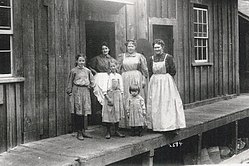Falk Archaeological District | |
 Residents of the town of Falk | |
| Location | Headwaters Forest Reserve, Humboldt County, California, United States |
|---|---|
| Coordinates | 40°41′22.1″N 124°7′50.94″W / 40.689472°N 124.1308167°W |
| Built | 1884 |
| NRHP reference No. | 100009504 |
| Significant dates | |
| Added to NRHP | November 9, 2023 |
| Designated HD | HD |
The Falk Archaeological District encompasses a historic town and lumber mill site in Northern California, United States. Included in the Headwaters Forest Reserve in 1999, the town was founded by Noah and Elijah Falk. [1] The site was listed on the National Register of Historic Places in 2023. [2]
History
Noah Falk came to California in 1854 and formed the Elk River Mill and Lumber Company with two partners. The town was built around the sawmill in 1884 to house the families of immigrant lumberjacks from Sweden, Norway, Ireland and Nova Scotia.Workers toiled deep in the now-protected redwood stands, felling trees, shipping them on Falk’s very own railroad to the mill, and finally sending the lumber to worldwide markets via a port at present day Eureka. [2] The town of 400 with a cookhouse, a dance hall, a general store, a post office and a school [3] thrived until 1937 when the Great Depression closed the lumber mill and the town was soon abandoned. [4] Among the last residents were Charlie Webb and his wife who acted as property caretakers for the lumber company. [3] After Charlie died, the lumber company burned and demolished the buildings in 1979 due to liability concerns and a plaque stands in its place. [5]
Description
Remnants of the townsite are visible and marked with interpretive signs along the first half-mile of the Elk River Trail. The restored locomotive barn serves as an education center. [2]
References
![]() This article incorporates
public domain material from websites or documents of the
Bureau of Land Management.
This article incorporates
public domain material from websites or documents of the
Bureau of Land Management.
- ^ Gates, Jon Humboldt. (1983). Falk's claim : the life and death of a redwood lumber town. Moonstone Pub. ISBN 1878136011. OCLC 33283127.
- ^ a b c "Falk townsite in Headwaters Forest Reserve named to National Register of Historic Places" (Press release). Bureau of Land Management. January 9, 2024.
- ^ a b Harrell, Ashley (October 29, 2021). "Eerie remnants of a ghost town lurk within this California forest". SFGate. Retrieved October 29, 2021.
- ^ Turner, Dennis W. & Gloria H. (2010). Place Names of Humboldt County. Orangeville, CA: Dennis W. & Gloria H. Turner. p. 89. ISBN 978-0-9629617-2-4.
- ^ Greenson, Thadeus (April 19, 2007). "Falk is not forgotten". Times-Standard. Retrieved June 22, 2021.
External links
- Falk Historic Logging Ghost Town. Eureka-Humboldt Visitors Bureau.
- Humboldt Heritage Trails. Eureka-Humboldt Visitors Bureau.
Falk Archaeological District | |
 Residents of the town of Falk | |
| Location | Headwaters Forest Reserve, Humboldt County, California, United States |
|---|---|
| Coordinates | 40°41′22.1″N 124°7′50.94″W / 40.689472°N 124.1308167°W |
| Built | 1884 |
| NRHP reference No. | 100009504 |
| Significant dates | |
| Added to NRHP | November 9, 2023 |
| Designated HD | HD |
The Falk Archaeological District encompasses a historic town and lumber mill site in Northern California, United States. Included in the Headwaters Forest Reserve in 1999, the town was founded by Noah and Elijah Falk. [1] The site was listed on the National Register of Historic Places in 2023. [2]
History
Noah Falk came to California in 1854 and formed the Elk River Mill and Lumber Company with two partners. The town was built around the sawmill in 1884 to house the families of immigrant lumberjacks from Sweden, Norway, Ireland and Nova Scotia.Workers toiled deep in the now-protected redwood stands, felling trees, shipping them on Falk’s very own railroad to the mill, and finally sending the lumber to worldwide markets via a port at present day Eureka. [2] The town of 400 with a cookhouse, a dance hall, a general store, a post office and a school [3] thrived until 1937 when the Great Depression closed the lumber mill and the town was soon abandoned. [4] Among the last residents were Charlie Webb and his wife who acted as property caretakers for the lumber company. [3] After Charlie died, the lumber company burned and demolished the buildings in 1979 due to liability concerns and a plaque stands in its place. [5]
Description
Remnants of the townsite are visible and marked with interpretive signs along the first half-mile of the Elk River Trail. The restored locomotive barn serves as an education center. [2]
References
![]() This article incorporates
public domain material from websites or documents of the
Bureau of Land Management.
This article incorporates
public domain material from websites or documents of the
Bureau of Land Management.
- ^ Gates, Jon Humboldt. (1983). Falk's claim : the life and death of a redwood lumber town. Moonstone Pub. ISBN 1878136011. OCLC 33283127.
- ^ a b c "Falk townsite in Headwaters Forest Reserve named to National Register of Historic Places" (Press release). Bureau of Land Management. January 9, 2024.
- ^ a b Harrell, Ashley (October 29, 2021). "Eerie remnants of a ghost town lurk within this California forest". SFGate. Retrieved October 29, 2021.
- ^ Turner, Dennis W. & Gloria H. (2010). Place Names of Humboldt County. Orangeville, CA: Dennis W. & Gloria H. Turner. p. 89. ISBN 978-0-9629617-2-4.
- ^ Greenson, Thadeus (April 19, 2007). "Falk is not forgotten". Times-Standard. Retrieved June 22, 2021.
External links
- Falk Historic Logging Ghost Town. Eureka-Humboldt Visitors Bureau.
- Humboldt Heritage Trails. Eureka-Humboldt Visitors Bureau.